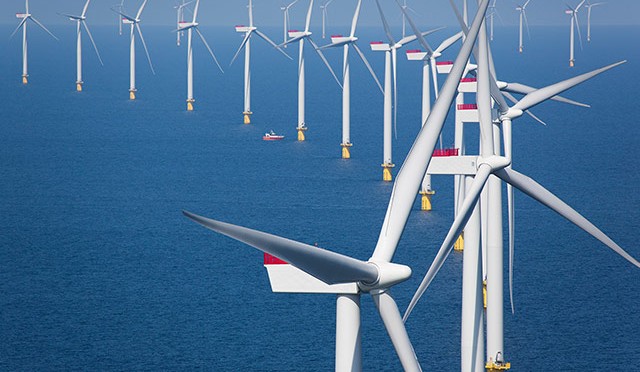A massive offshore wind energy project has today been given the go ahead by the Government and is expected to support up to 900 green jobs in Yorkshire and Humberside and millions of pounds’ worth of investment to the UK’s economy.
Dogger Bank Creyke Beck is now the largest consented offshore wind energy project in the world, with an installed capacity of up to 2.4 gigawatts (GW), enough to meet the needs of 1.8 million households, and on its own supply around 2.5% of UK electricity.
The proposed site of the two adjacent wind farms (Creyke Beck A and B) is 81 miles from the shore at its closest point, covering a maximum area of 430 square miles. Each of the sites will have a capacity of up to 1.2GW, and would reduce carbon emissions by almost four million tonnes a year.
It is the furthest offshore wind project from UK shores, while remaining in shallow waters of approximately 30 metres. This means that it will be at the cutting edge of advancements in offshore wind farm development across the world. It is also the first consented phase of the much larger Dogger Bank zone, which comprises six sites with an estimated total capacity of up to 7.2GW.
Dogger Bank Creyke Beck will now enter a pre-construction phase, before the final investment decision is made. It could create up to 4,750 new direct and indirect full time equivalent jobs over the 25-year lifespan of the project.
Energy Secretary Ed Davey said: “This is another great boost for Yorkshire and Humberside. This development has the potential to support hundreds of green jobs and power up to 2 million homes.
“Making the most of Britain’s home grown energy is creating jobs and businesses in the UK, getting the best deal for consumers and reducing our reliance on foreign imports. Wind power is vital to this plan, with £14.5 billion invested since 2010 into an industry which supports 35,400 jobs.”
RenewableUK’s Director of Offshore Renewables, Nick Medic, added: “This is an awesome project. It will surely be considered as one of the most significant infrastructure projects ever undertaken by the wind industry. A colossal wind energy power station right in the middle of the North Sea, comprising hundreds of offshore wind turbines over 80 miles off shore.
“Dogger Bank demonstrates the sheer potential of offshore technology to turn our vast ocean and wind resources into green energy. It is a project that pushes the offshore engineering envelope – demonstrating how far this technology has evolved in the ten short years since the first major offshore wind farm was installed in North Hoyle just 5 miles from shore.
“The Dogger Bank projects now in planning could supply around 5% of UK electricity. We need to make sure that this project as well as other worthy offshore projects around these islands are adequately supported and funded. In return, offshore wind will generate much more than just electricity: it will turn the country into a green-economy powerhouse, creating jobs and business growth for years to come.
“Finally, we offer our congratulations for the team at the Forewind consortium taking this project to its consent.”
Almost half of the costs associated with building and operating a wind farm are spent buying services and products from UK businesses. This translates into real jobs, particularly in areas like Yorkshire which is becoming an energy hub.
Siemens and ABP announced a combined investment of £310 million to develop new wind turbine production and installation facilities in Hull last year, creating over 1,000 new jobs. This is one of the largest investments in the Humberside area in the last 50 years and demonstrates that the UK is the leading market for the sector.



